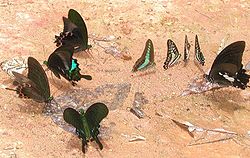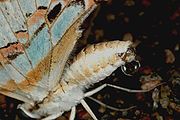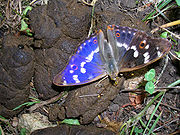
Mud-puddling
Encyclopedia

Butterfly
A butterfly is a mainly day-flying insect of the order Lepidoptera, which includes the butterflies and moths. Like other holometabolous insects, the butterfly's life cycle consists of four parts: egg, larva, pupa and adult. Most species are diurnal. Butterflies have large, often brightly coloured...
and involves their aggregation on substrates like wet soil
Soil
Soil is a natural body consisting of layers of mineral constituents of variable thicknesses, which differ from the parent materials in their morphological, physical, chemical, and mineralogical characteristics...
, dung and carrion
Carrion
Carrion refers to the carcass of a dead animal. Carrion is an important food source for large carnivores and omnivores in most ecosystems. Examples of carrion-eaters include vultures, hawks, eagles, hyenas, Virginia Opossum, Tasmanian Devils, coyotes, Komodo dragons, and burying beetles...
to obtain nutrients such as salt
Salt
In chemistry, salts are ionic compounds that result from the neutralization reaction of an acid and a base. They are composed of cations and anions so that the product is electrically neutral...
s and amino acids. This behaviour has also been seen in some other insects, notably the leafhopper
Leafhopper
Leafhopper is a common name applied to any species from the family Cicadellidae. Leafhoppers, colloquially known as hoppers, are minute plant-feeding insects in the superfamily Membracoidea in the order Hemiptera...
s.
Lepidoptera
Lepidoptera
Lepidoptera is a large order of insects that includes moths and butterflies . It is one of the most widespread and widely recognizable insect orders in the world, encompassing moths and the three superfamilies of butterflies, skipper butterflies, and moth-butterflies...
(butterflies and moths) are diverse in their strategies to gather liquid nutrients. Typically, mud-puddling behavior takes place on wet soil. But even sweat on human skin may be attractive to butterflies. The most unusual sources include blood
Blood
Blood is a specialized bodily fluid in animals that delivers necessary substances such as nutrients and oxygen to the cells and transports metabolic waste products away from those same cells....
and tear
Tear
Tear may refer to:*Tears, a type of eye secretion*Tearing, the ripping apart of something by force*Robert Tear, a Welsh singer-Elements in fiction:*Tear, a character Tear Grants in video game Tales of the Abyss...
s (see below).
This behaviour is restricted to males in many species
Species
In biology, a species is one of the basic units of biological classification and a taxonomic rank. A species is often defined as a group of organisms capable of interbreeding and producing fertile offspring. While in many cases this definition is adequate, more precise or differing measures are...
, and in some like Battus philenor the presence of an assembly of butterflies on the ground acts as a stimulus to join the presumptive mud-puddling flock.
Mud-puddling on soil

India
India , officially the Republic of India , is a country in South Asia. It is the seventh-largest country by geographical area, the second-most populous country with over 1.2 billion people, and the most populous democracy in the world...
this phenomenon is mostly seen in the post-monsoon
Monsoon
Monsoon is traditionally defined as a seasonal reversing wind accompanied by corresponding changes in precipitation, but is now used to describe seasonal changes in atmospheric circulation and precipitation associated with the asymmetric heating of land and sea...
season. The groups can include several species often including members of the Papilionidae and Pieridae
Pieridae
The Pieridae are a large family of butterflies with about 76 genera containing approximately 1,100 species, mostly from tropical Africa and Asia. Most pierid butterflies are white, yellow or orange in coloration, often with black spots...
.
Males seem to benefit from the sodium uptake through mud-puddling behaviour with an increase in reproductive success. The collected sodium and amino acids are often transferred to the female with the spermatophore
Spermatophore
A spermatophore or sperm ampulla is a capsule or mass created by males of various animal species, containing spermatozoa and transferred in entirety to the female's ovipore during copulation...
during mating as a nuptial gift. This nutrition also enhances the survival rate of the eggs.
When puddling many butterflies and moths pump fluid through the digestive tract and release fluid from their anus. In some, such as the male notodontid
Notodontidae
Notodontidae is a family of moths with approximately 3,500 known species. Moths of this family are found in all parts of the world, but they are most concentrated in tropical areas, especially in the New World...
Gluphisia septentrionis, this is released in forced anal jets at 3 second intervals. Fluid of up to 600 times the body mass may pass through and males have a much longer ileum (anterior hindgut) than non-puddling females.
Other sources of liquid nutrients

Orthoptera
Orthoptera is an order of insects with paurometabolous or incomplete metamorphosis, including the grasshoppers, crickets and locusts.Many insects in this order produce sound by rubbing their wings against each other or their legs, the wings or legs containing rows of corrugated bumps...
– e.g. the Yellow-spined Bamboo Locust (Ceracris kiangsu) – are attracted to human urine, specifically to the sodium and ammonium ions in it. Those Lepidoptera
Lepidoptera
Lepidoptera is a large order of insects that includes moths and butterflies . It is one of the most widespread and widely recognizable insect orders in the world, encompassing moths and the three superfamilies of butterflies, skipper butterflies, and moth-butterflies...
that are attracted to dung (e.g. Zeuxidia
Zeuxidia
Zeuxidia is a genus of very large butterflies in the family Nymphalidae....
spp.) or carrion seem to be prefer ammonium
Ammonium
The ammonium cation is a positively charged polyatomic cation with the chemical formula NH. It is formed by the protonation of ammonia...
ion
Ion
An ion is an atom or molecule in which the total number of electrons is not equal to the total number of protons, giving it a net positive or negative electrical charge. The name was given by physicist Michael Faraday for the substances that allow a current to pass between electrodes in a...
s rather than sodium. By rotting, fruits make available to butterflies sugar
Sugar
Sugar is a class of edible crystalline carbohydrates, mainly sucrose, lactose, and fructose, characterized by a sweet flavor.Sucrose in its refined form primarily comes from sugar cane and sugar beet...
s and their derivatives such as alcohol
Alcohol
In chemistry, an alcohol is an organic compound in which the hydroxy functional group is bound to a carbon atom. In particular, this carbon center should be saturated, having single bonds to three other atoms....
s, which are mainly useful as carbohydrate
Carbohydrate
A carbohydrate is an organic compound with the empirical formula ; that is, consists only of carbon, hydrogen, and oxygen, with a hydrogen:oxygen atom ratio of 2:1 . However, there are exceptions to this. One common example would be deoxyribose, a component of DNA, which has the empirical...
"fuel" for ATP
Adenosine triphosphate
Adenosine-5'-triphosphate is a multifunctional nucleoside triphosphate used in cells as a coenzyme. It is often called the "molecular unit of currency" of intracellular energy transfer. ATP transports chemical energy within cells for metabolism...
production.
In Borneo lowland rain forest
Borneo lowland rain forest
Borneo lowland rain forest is an ecoregion, within the Tropical and subtropical moist broadleaf forests Biome, of the large island of Borneo in Southeast Asia. It supports approximately 10,000 plant species, 380 bird species and several mammal species...
, numerous species of butterflies regularly visit decaying fruit to drink. This behavior is mainly opportunistic, though some are highly attracted to old fruit, notably Satyrinae
Satyrinae
Satyrinae, the satyrines or satyrids, commonly known as the Browns, is a subfamily of the Nymphalidae . They were formerly considered a distinct family, Satyridae. This group contains nearly half of the known diversity of brush-footed butterflies...
(e.g. Neorina lowii) and Limenitidinae
Limenitidinae
Limenitidinae is a subfamily of butterflies that includes the admirals and relatives. The common names of many species and genera reference military ranks or – namely the Adoliadini – titles of nobility , in reference to these butterflies' large size, bold pattern and dashing flight...
such as Bassarona dunya
Bassarona dunya
Bassarona dunya is a butterfly of the Nymphalidae family. It is found in south-east Asia.-Subspecies:*Bassarona dunya dunya *Bassarona dunya mahara Fruhstorfer...
.
Carrion
Carrion
Carrion refers to the carcass of a dead animal. Carrion is an important food source for large carnivores and omnivores in most ecosystems. Examples of carrion-eaters include vultures, hawks, eagles, hyenas, Virginia Opossum, Tasmanian Devils, coyotes, Komodo dragons, and burying beetles...
is usually more intentionally utilized. Carrion-feeders seem to represent a different feeding guild from "classical" mud-puddlers and fruit-feeders. They include diverse taxa, e.g. brush-footed butterflies such as Cirrochroa emalea of the Nymphalinae
Nymphalinae
Nymphalinae is a subfamily of brush-footed butterflies . Sometimes, the Limenitidinae are included here as further tribe, while the Melitaeini are occasionally considered a distinct subfamily.- Systematics:...
or the Tawny Rajah (Charaxes bernardus) of the Charaxinae
Charaxinae
Charaxinae, the leafwings, is a nymphalid subfamily of butterflies that includes about 400 species, inhabiting mainly the tropics, although some species extend into temperate regions in North America, Europe, China and southern Australia. There are significant variations between the species...
, as well as gossamer-winged butterflies like Curetis tagalica of the Curetinae or the Common Imperial (Cheritra freja) of the Theclinae
Theclinae
Subfamily Theclinae is a group of butterflies, including the hairstreaks, elfins and allies, in the family Lycaenidae. There are many tropical species as well as a number found in the Americas. Tropical hairstreaks often have iridescent blue coloration above, caused by reflected light from the...
.

Evolution
Evolution is any change across successive generations in the heritable characteristics of biological populations. Evolutionary processes give rise to diversity at every level of biological organisation, including species, individual organisms and molecules such as DNA and proteins.Life on Earth...
independently in several lineages. Specialist carrion-feeders may even have the ability to smell out and home in on rotting meat over hundreds of meters. In the Bornean Charaxinae
Charaxinae
Charaxinae, the leafwings, is a nymphalid subfamily of butterflies that includes about 400 species, inhabiting mainly the tropics, although some species extend into temperate regions in North America, Europe, China and southern Australia. There are significant variations between the species...
, Specialist (Charaxes bernardus) or opportunistic (some other Charaxes
Charaxes
Charaxes has several meanings:*Charaxes, the genus of pasha and radjah butterflies*The name taken by the comic book villain Killer Moth after his transformation into an actual killer moth-like creature....
and Polyura
Polyura
Polyura is the genus of nawab butterflies. They belong to the brush-footed butterfly subfamily Charaxinae, or leafwing butterflies. Like the large and conspicuous pasha and rajah butterflies they belong to the Charaxini tribe....
) tend to have a markedly larger bulk and smaller wings, making them more dashing, maneuvrable flyers than fruit specialists like Prothoe franck
Prothoe franck
The Blue Begum is a butterfly species found in Assam in northeastern India and throughout a large part of southeast Asia.It belongs to the leafwings in the brush-footed butterflies family.-References:...
and opportunistic fruit visitors such as Charaxes durnfordi
Charaxes durnfordi
The Chestnut Rajah is a butterfly found in India that belongs to the Rajahs and Nawabs group, that is, the Charaxinae group of the Brush-footed butterflies family.-Description:...
. Other butterflies like most Pieridae
Pieridae
The Pieridae are a large family of butterflies with about 76 genera containing approximately 1,100 species, mostly from tropical Africa and Asia. Most pierid butterflies are white, yellow or orange in coloration, often with black spots...
, Papilionidae and Morphinae
Morphinae
Morphinae is a subfamily of Nymphalidae butterflies that includes the morphos, the owl butterflies and related lineages. It is either considered a sister group of the Satyrinae, or disassembled and included therein.- Systematics :...
are rarely if ever seen on carrion, dung and rotting fruit, though they may be avid mud-puddlers in the strict sense. Altogether, the Nymphalidae
Nymphalidae
The Nymphalidae is a family of about 5,000 species of butterflies which are distributed throughout most of the world. These are usually medium sized to large butterflies. Most species have a reduced pair of forelegs and many hold their colourful wings flat when resting. They are also called...
show the highest variety of nutrient-gathering strategies among the butterflies; the Limenitidinae
Limenitidinae
Limenitidinae is a subfamily of butterflies that includes the admirals and relatives. The common names of many species and genera reference military ranks or – namely the Adoliadini – titles of nobility , in reference to these butterflies' large size, bold pattern and dashing flight...
have numerous mud-puddlers that also frequently visit dung but avoid fruits and carrion (namely the genus Limenitis
Limenitis
Limenitis is a genus of brush-footed butterflies, commonly called the Admirals. The Sister butterflies and Commander butterflies are sometimes included here....
), and some which are attracted to any pungent substance.
Certain moth
Moth
A moth is an insect closely related to the butterfly, both being of the order Lepidoptera. Moths form the majority of this order; there are thought to be 150,000 to 250,000 different species of moth , with thousands of species yet to be described...
s, mainly of the subfamily Calpinae
Calpinae
Calpinae is a subfamily of moth family Noctuidae. It is closely related to the Catocalinae; both subfamilies contain large species with wingspans larger than 5 centimetres ....
, are somewhat notorious for their blood- and tear-drinking habits. Hemiceratoides hieroglyphica
Hemiceratoides hieroglyphica
Hemiceratoides hieroglyphica is a moth from Madagascar. It was discovered in 2006 that it frequents sleeping birds at night, and drinks their tears, using a specialized, harpoon-like proboscis...
of Madagascar
Madagascar
The Republic of Madagascar is an island country located in the Indian Ocean off the southeastern coast of Africa...
has been noted to visit and suck tears by inserting their proboscis into the closed eyelids of roosting birds. Some species of the genus
Genus
In biology, a genus is a low-level taxonomic rank used in the biological classification of living and fossil organisms, which is an example of definition by genus and differentia...
Calyptra
Calyptra (moth)
The genus Calyptra is a group of moths in subfamily Calpinae of the family Noctuidae. They are a member of the Calpini tribe. whose precise circumscription is uncertain but includes a number of other fruit-piercing or eye-frequenting genera currently classified in Calpinae.The common name of many...
are called "vampire moths" as they suck blood from sleeping vertebrate
Vertebrate
Vertebrates are animals that are members of the subphylum Vertebrata . Vertebrates are the largest group of chordates, with currently about 58,000 species described. Vertebrates include the jawless fishes, bony fishes, sharks and rays, amphibians, reptiles, mammals, and birds...
s, including humans. Ophthalmotropy (= eye-attraction) or lachryphagy (= tear drinking) is noted in a number of unrelated moths which visit mammal
Mammal
Mammals are members of a class of air-breathing vertebrate animals characterised by the possession of endothermy, hair, three middle ear bones, and mammary glands functional in mothers with young...
s.
See also
- PuddlePuddleA puddle is a small accumulation of liquid, usually water, on a surface. It can form either by pooling in a depression on the surface, or by surface tension upon a flat surface...
- Seep (hydrology)Seep (hydrology)A Seep is a moist or wet place where water, usually groundwater, reaches the earth's surface from an underground aquifer.-Description:Seeps are usually not of sufficient volume to be flowing beyond their above-ground location. They are part of the limnology-geomorphology system...
- Spring (hydrology)
- HabitatHabitat* Habitat , a place where a species lives and grows*Human habitat, a place where humans live, work or play** Space habitat, a space station intended as a permanent settlement...
- Restoration ecologyRestoration ecology-Definition:Restoration ecology is the scientific study and practice of renewing and restoring degraded, damaged, or destroyed ecosystems and habitats in the environment by active human intervention and action, within a short time frame...
- Riparian zone restorationRiparian zone restorationRiparian zone restoration is the ecological restoration of riparian zone habitats of streams, rivers, springs, lakes, floodplains, and other hydrologic ecologies.Riparian zones have been degraded throughout much of the world...

